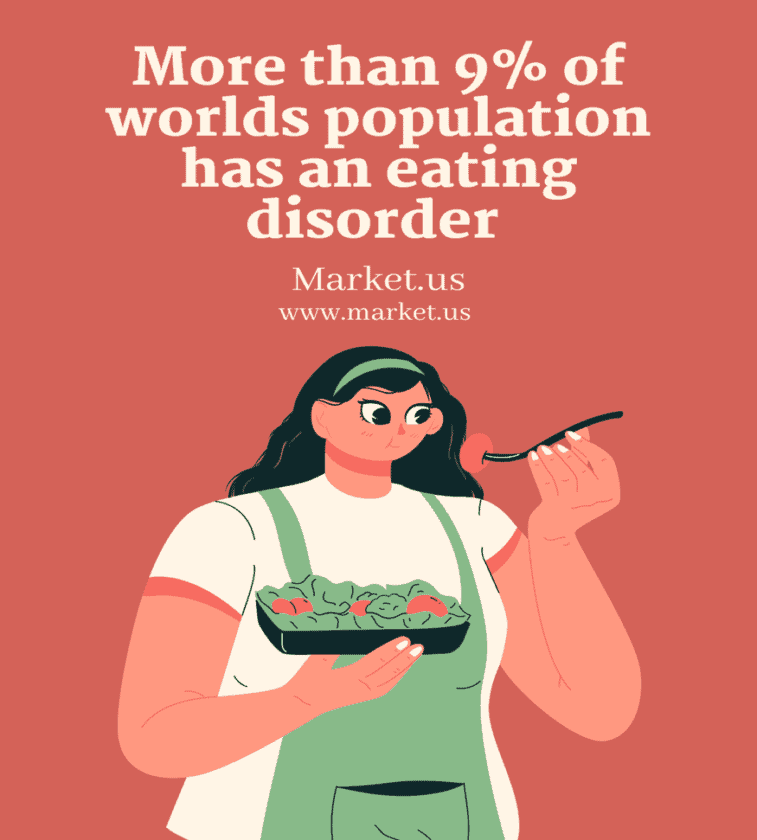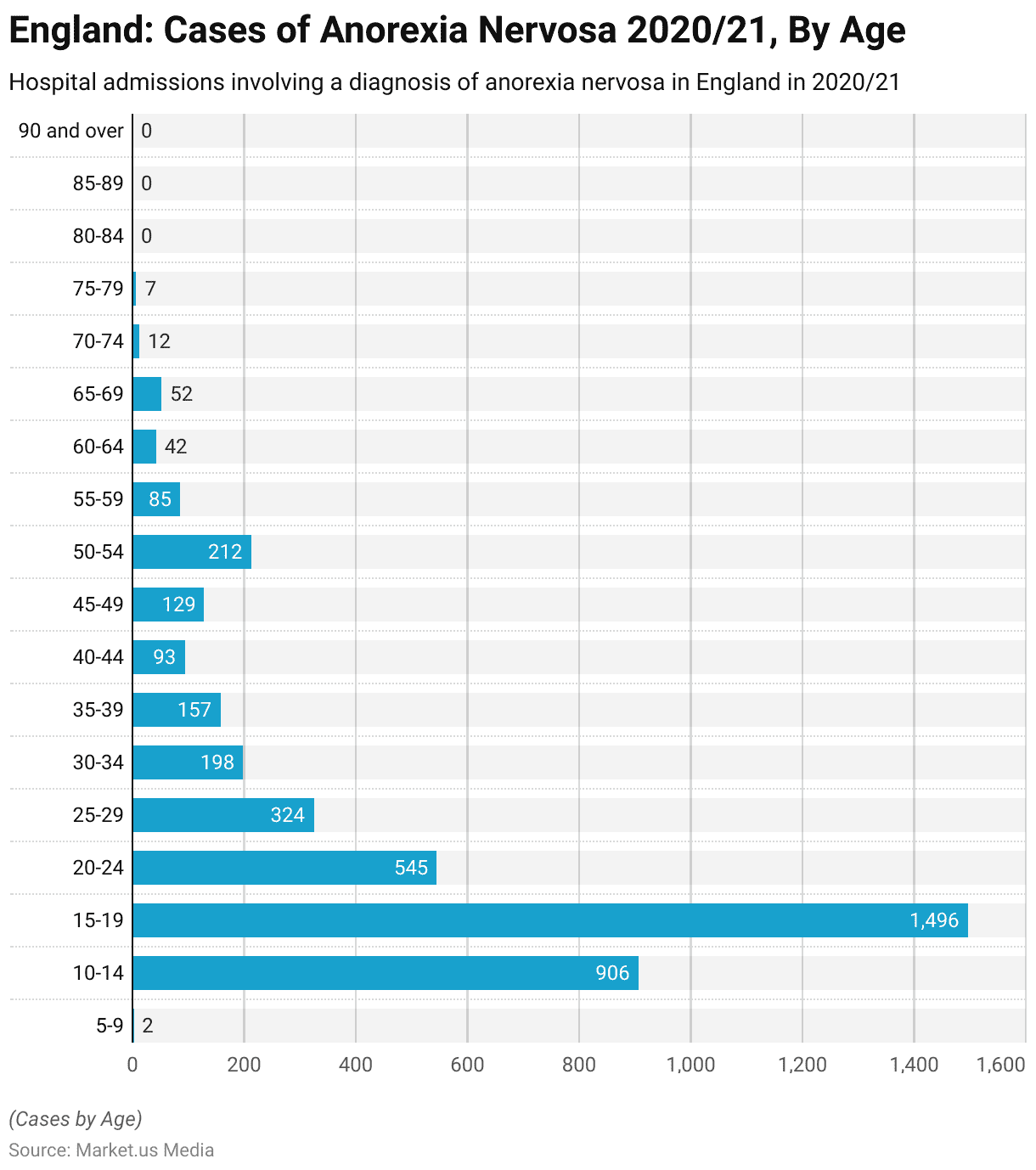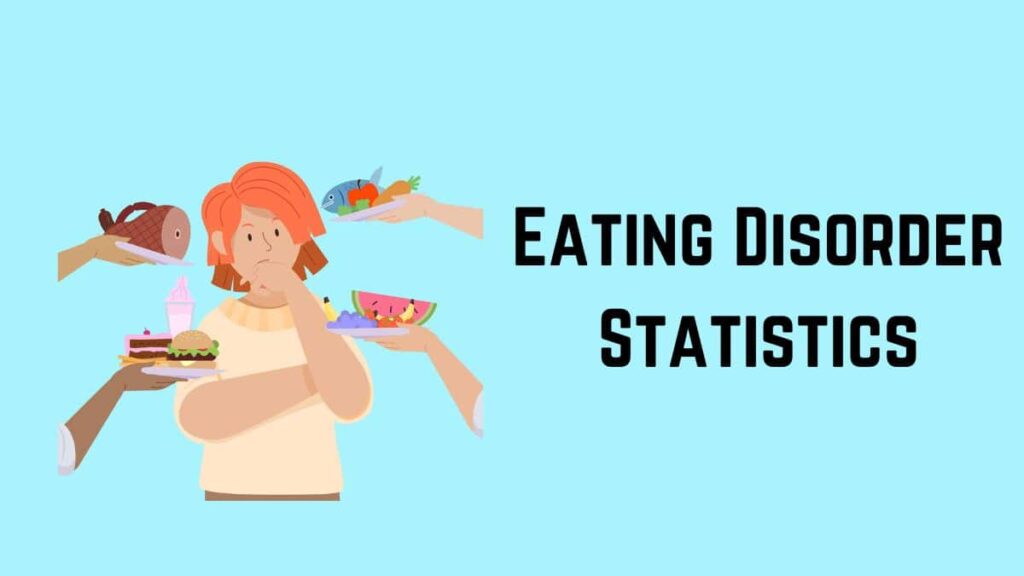Eating Disorder Statistics:- Eating disorders affect people of every age, race, size, sexual orientation, gender identity, and background.
More than 9% of the world’s population has an eating disorder. An eating disorder is a serious mental disorder that causes severe disturbance to a person’s eating behavior.
Eating disorders are often associated with distorted body image and preoccupation with weight and appearance.
The factors that can contribute to the development of eating disorders include genetic predisposition, environmental factors, and psychological factors.
Eating disorder statistics help you to get insights into how eating disorders are emerging among individuals worldwide.

Eating Disorders
An eating disorder is a mental health condition that involves unhealthy eating behaviors and distorted relationships with food and body weight.
Dynamics
Perfectionism is another element that is slated to boost the projected revenue growth of the virtual eating disorder treatment market as well. However, a surge in the prevalence of eating disorders, and cases of sleep deprivation, particularly in adults, more so among the adult female population.
Types of Eating Disorders
Anorexia nervosa
Bulimia nervosa
Binge-eating disorder
Avoidant/Restrictive Food Intake Disorder (ARFID)
Orthorexia Nervosa
Other Specified Feeding or Eating Disorder (OSFED)

Top Eating Disorder
Less than 6% of individuals across the globe are medically diagnosed.
28% to 74% of the risks of eating disorders are through genetic heritability.
More than 10,200 deaths are due to eating disorders worldwide every year.
Around 26% of individuals worldwide attempt suicide due to eating disorders.
More than 30% of people with eating disorders have experienced sexual abuse.
It is estimated that approximately 70 million people worldwide suffer from eating disorders.
Eating disorders have a high mortality rate of any mental illness, with an estimated 10% of individuals with anorexia nervosa.
Eating disorders are the third most common chronic illness among adolescents.
Women and girls are more likely to develop eating disorders than men and boys.
More than 10% of young women have eating disorders.
(Source: National Eating Disorders, National Association of Anorexia Nervosa and Associated Disorders, NIMH, WHO)
Prevalence of Anorexia Nervosa Eating Disorder Statistics
Anorexia nervosa is a serious eating disorder that affects both men and women, but this disorder is more common in women. This disorder is characterized by a distorted body image, an intense fear of gaining weight, and persistent restrictions on food intake, which leads to severe weight loss.
Individuals with this disorder often have a body weight that is much lower than healthy weight according to their age, height, and gender. The disorder has serious physical and psychological consequences, including low blood pressure, irregular heartbeat, and anemia. Osteoporosis, depression, and fertility.
The lifetime prevalence of anorexia nervosa in adults is 0.6%.
The lifetime prevalence of anorexia nervosa in females is three times higher than in males.
More than 10 million people in the United States will develop an eating disorder within their lifetime.
About one-third of transgender people with eating disorders.
35% of female college athletes have an elevated risk of anorexia nervosa.
10% of male athletes have an elevated risk of eating disorder anorexia nervosa.
About 20% of people with autism have anorexia nervosa disorder.
95% of people with anorexia nervosa are between the ages of 12 to 25 years.
1 out of 100 young women between the ages of 10 to 10 years had an anorexia nervosa eating disorder.
Anorexia nervosa commonly occurs in individuals with mental illness.
12% to 21% of people with substance disorders have anorexia nervosa disorder.
20% to 60% of people with anxiety disorder have anorexia nervosa disorder.
15% to 60% of people with depressive disorder have anorexia nervosa disorder.
People with anorexia nervosa eating disorder are more likely to die by suicide than the general population.
67% of people with anorexia have a traumatic event that contributes to their eating disorder.
(Source: bulimia, centerfordiscovery)
Eating Disorder Prevalence, Incidence & Trends In Asia
It is very important to recognize the size and scope of Asia, which contributes the largest share both in terms of landmass and population.
A closer look at patterns and trends by country
About 8.7% of females are suffering from eating disorders in Singapore.
About 50% of young adults with eating disorders in Singapore did not seek professional help.
It is estimated that around 3% of young adult women have an eating disorder, which is higher than the estimated prevalence of 1% to 2% in the general population.
About 14.8% of females have Eating Distress syndrome.
The prevalence of eating disorders in Hong Kong was around 3%, with anorexia Nervosa being the most common eating disorder.
The prevalence of eating disorders among female medical students in Southern India was around 13%.
It was found that non-fat-phobic anorexia nervosa accounted for only around 2% of cases of anorexia nervosa.
1.6% of people in Pakistan have an Eating Syndrome disorder.
33.73% of women’s in Fiji reported experiencing dissatisfaction with their weight.
78.8% of students in Pakistan evidenced some degree of body dissatisfaction.
40.4% of females in Pakistan are significantly more concerned about being thin.
10.4% of students in Fiji have an elevated risk of ED.
(Source: jeatdisord, EDS)
Bulimia Nervosa Eating Disorder
Bulimia nervosa is an eating disorder characterized by recurrent episodes of binge eating, followed by purging behaviors such as vomiting, using laxatives or diuretics, fasting, or excessive exercise.
People with bulimia nervosa disorder often feel a lack of control during binge eating episodes, which are typically accompanied by feeling the guilt of shame, and self-disgust.
This disorder is more common in women than men and typically develops in adolescence or young adulthood.
The lifetime prevalence of bulimia nervosa for adult women ranges from 1.7%-2.0% and for men it ranges from 0.5%-0.7%.
5.1% of girls with ethnic minority youth have bulimia nervosa disorder.
2.35 of boys with ethnic minorities have bulimia nervosa disorder.
49% of youth with bulimia nervosa have major depression.
66% of youth with bulimia nervosa have anxiety disorder.
2% of adolescent boys/girls with diabetes engaged in self-included vomiting.
21% OF Bahraini young adults have bulimic nervosa symptoms.
The prevalence of bulimia nervosa is higher in Middle Eastern Countries.
More than 40% of people with bulimia nervosa disorder reported symptoms of depression and anxiety due to lockdown.
92% of hospital admissions for bulimia nervosa are for women.
52% of hospitalized patients for bulimia nervosa have schizophrenia disorder and 23% of patients have depression disorder.
More than 34% of people with bulimia nervosa experience night-eating syndrome.
(Source: breakbingeeating)
Binge-Eating Disorder
Binge-eating disorder (BED) is an eating disorder characterized by recurrent episodes of binge eating, in which a person consumes an abnormally large amount of food within a short period. Unlike bulimia nervosa, people with BED do not engage in compensatory behaviors, such as purging or excessive exercise, after binge eating episodes.
Symptoms of Binge-eating Disorder
Regularly eating more food than most people
Feeling out of control while you’re eating
Eating fast or past the point of feeling full
Experiencing negative feelings of shame, guilt, or remorse about binge eating
Eating a lot even when you’re not hungry
Binge-eating disorder is characterized by episodes of excessive food consumption over a short period. Below are some key statistics on Binge-eating disorder.
Binge-eating disorder is most common in the United States.
This disorder affects about 2.8 million adults in the United States.
78.9% of the people with binge-eating disorder have another mental health disorder.
65.1% of individuals with binge-eating disorder have anxiety symptoms.
43.6% of individuals with binge-eating disorder are females.
The binge-eating disorder affects three times the number of those diagnosed with anorexia and bulimia nervosa.
The binge-eating disorder affects about 2% of the American Population.
30% of patients who have had gastric bypass surgery (GBS) meet the DSM-5 criteria for binge eating disorder (BEDA).
The binge-eating disorder affects 3.5% of women in the United States.
2% of men in the United States are affected with binge-eating disorder.
1.6% of adolescents with binge-eating disorder in the United States.
(Source: The Recovery Village, Walden eating disorders)
Avoidant/Restrictive Food Intake Disorder (ARFID)
Avoidant/Restrictive Food Intake Disorder (ARFID) is an eating disorder characterized by a persistent lack of interest in food or avoidance of certain foods, which results in inadequate nutrient intake and weight loss. AFRID can occur both in children and adults, and it is often associated with sensory sensitivity and fear of choking or vomiting.
Symptoms of AFRID
Lack of interest in food
Avoiding foods due to texture or consistency
Being a “picky” eater
Refusing to try new foods
Requiring food to be prepared in a specific way
Feeling afraid to eat due to fear of a possible allergic reaction, choking, or vomiting
What are the Latest ARFID Facts and Eating Disorder Statistics?
AFRID is most common in children and young adolescents and less common in late adolescence and adulthood.
About 72% of patients with AFRID have an anxiety disorder.
28.7% of ARFID patients had selective eating since early childhood.
19.4% of patients with AFRID have gastrointestinal symptoms.
13.2% of patients had an early history of vomiting or choking.
4.1% of people with AFRID have food allergies and 13.2% had other reasons for their restricted eating.
(Source: ScienceDirect)
Orthorexia Nervosa
Orthorexia nervosa is an eating disorder characterized by an obsessive preoccupation with eating only healthy foods. People with orthorexia nervosa may restrict their food intake to a narrow range of pure foods that they believe are healthy. This disorder can lead to a range of physical and psychological problems, such as malnutrition, social isolation, and anxiety or depression.
Symptoms of Orthorexia Nervosa Eating Disorder Statistics
Engaging in emotional eating.
Self-esteem is based on eating healthy foods.
Increasingly critical and more rigid about eating.
Feeling as if certain foods are dangerous.
Feeling guilt or ashamed when unable to maintain diet standards.
Lose interest in activities once enjoyed because they are solely involved in eating healthy.
Thinking critically of others who don’t follow a strict diet.
Prevalence of Orthorexia Nervosa Eating Disorder Statistics
About 1%-7% of the world population is affected with orthorexia nervosa eating disorder.
Orthorexia nervosa is most common in women as compared to men.
Orthorexia nervosa is common in college students as 25% of students at university experienced symptoms of orthorexia nervosa.
85% of students who perform any sports activity experienced symptoms of anorexia nervosa.
Orthorexia nervosa is common in athletes, 52% of athletes have anorexia nervosa eating disorder.
(Source: the recovery village)
People with Disabilities Eating Disorder Statistics
Women with any physical disability are more likely to develop eating disabilities.
About 20-30% of adults with eating disorders have autism.
More than 3% of children and young people with eating disorders have autism.
Prevalence of Dieting Statistics
More than 50% of teenage girls and 33% of teenage boys are using restrictive measures to lose body weight.
91% of women on a college campus have attempted to control weight through dieting.
35% of normal dieters progress to pathological dieting.
About 25% of American men and 45% of American women are on a diet.
(Source: eatingdisorderhope)
Research Funding For Anorexia In The United States From 2008 To 2023
From 2008 to 2021, research funding for anorexia increased from approximately 7 million U.S. dollars to an estimated 131 million U.S. dollars.
(Source: Statista)
This statistic illustrates research funding for anorexia in the United States from 2008 to 2023.

Cases Of Children With Eating Behavior Problems in Spain 2011-2023
Eating disorders are characterized by unhealthy feeding behaviors that impact mental and physical health. Anorexia, bulimia nervosa, and binge-eating disorder are common subtypes.
In 2021, the number of children with eating behavior problems registered within the Spanish National Health System amounted to around 19.2 thousand cases.
In 2022, the number of cases increased by 19.2 thousand to 225.8 thousand.
The number of children with eating behavior is expected to reach 27,609 at the end of the year 2023.
(Source: Statista)
Number of cases of eating behavior problems in children registered in Spain from 2011 to 2021

Hospital Admissions With A Diagnosis Of An Eating Disorder In England 2021, By Gender
Eating disorders are far more prevalent in women than in men. In 2021, over eight thousand women were admitted to hospital with anorexia compared to 360 men.
The prevalence of bulimia eating disorder is higher in females as compared to males. In 2021 about 8,085 females took hospital admission with primary or secondary diagnoses of eating disorders in England in 2021.
(Source: Statista)
Number of hospital admissions with a primary or secondary diagnosis of an eating disorder in England in 2021, by gender and diagnosis

Cases of Anorexia Nervosa in England in 2021, by Age
The most affected age group was 15 to 19 years with almost 1.5 thousand admissions for anorexia, followed by 906 diagnoses in the age group 10 to 14 years.
(Source: Statista)

Hospital Admissions Involving A Diagnosis Of Anorexia Nervosa In England In 2020/21, By Age
Eating Disorder Treatment Facilities In Italy 2021, By Region
As of year-end 2021, there were a total of 91 facilities to treat eating disorders across the whole Italian territory.
Basilicata and Aosta Valley have the lowest number of facilities to treat eating disorders.
This statistic breaks the number of eating disorder treatment facilities down by region where these structures were located.
According to the data, Emilia-Romagna was the region hosting the highest number of such facilities, with 16. Campania followed with 10.
(Source: Statista)
This statistic takes into account only eating disorder treatment facilities operated by the Italian National Health System.

Impacts Of Covid-19
The pandemic has caused widespread anxiety and stress, which boosted the eating disorder symptoms. Many treatment facilities and support groups for eating disorders have reduced their services due to COVID-19 restrictions.
During the COVID-19 pandemic, 41.9% of individuals reported reactivation of eating disorder symptoms.
About 25% of patients experienced worsening ED symptoms during the coronavirus pandemic.
During the COVID-19 pandemic, the incidence of eating disorders was 15.3% higher in 2020 as compared to previous years.
During the COVID-19 pandemic, the hospital admissions of people with ED increased by over 7.2% per month.
About 55.3% of females and 44.4% of males aged more than 15 years were diagnosed during the COVID-19 pandemic.
(Source: Clinical Trials Arena, Cambridge)
Recent Developments
Acquisitions and Mergers:
NutritionCare Inc. acquired EatingWell Solutions for $70 million, consolidating its expertise in nutrition therapy and eating disorder treatment services.
WellnessGroup merged with ED Recovery Center, forming a comprehensive network of eating disorder treatment facilities and counseling services, with combined revenues projected to exceed $200 million.
New Treatment Modalities:
EatHealthy introduced a meal planning app tailored for individuals with eating disorders, offering personalized nutrition guidance and meal tracking features, aiming to reach 500,000 downloads within the first year.
RecoveryMind launched a virtual support group platform for individuals recovering from eating disorders, providing peer support and professional guidance, with a target of 100,000 active users within six months.
Funding Rounds:
EatingDisorderCare received $40 million in Series A funding led by Healthcare Investment Group ABC to expand its network of specialized treatment centers and develop innovative therapies, targeting a 50% increase in patient admissions within the next year.
SupportiveEating secured $20 million in seed funding from Mental Health Investors XYZ to enhance their online counseling platform and launch educational resources for families and caregivers of individuals with eating disorders, aiming for a 40% growth in user engagement.
Consumer Trends:
Rising awareness of body positivity and mental health advocacy efforts led to a surge in demand for eating disorder treatment services, with admissions to residential treatment centers increasing by 30% compared to the previous year.
Online therapy platforms witnessed a 35% growth in usage among individuals seeking support for eating disorders, reflecting the growing acceptance of telehealth solutions in mental healthcare delivery.
Regulatory Landscape:
Regulatory bodies implemented guidelines for the accreditation and licensing of eating disorder treatment facilities, ensuring the quality of care and adherence to evidence-based treatment protocols, and fostering trust among patients and families seeking treatment options.
Conclusion
Eating Disorder Statistics – It is very important to note that eating disorders have a significant impact on individuals’ quality of life and can be life-threatening if left untreated. It is important to seek help from healthcare professionals as soon as possible.
More research is needed to deep understanding of the prevalence and impact of eating disorders. Anorexia nervosa, bulimia nervosa, binge-eating disorder, and avoidant/restrictive food intake disorder (ARFID) are common eating disorders and they have serious physical and psychological concerns.
Overall, individuals, healthcare professionals, and communities must prioritize education and resources that support prevention, early intervention, and treatments for eating disorders.
With rising awareness and access to care, many individuals with eating disorders can achieve successful recovery and improve their overall health and well-being.
FAQs
What is an eating disorder?
An eating disorder is a mental health condition that involves unhealthy eating behaviors and distorted relationships with food and body weight.
What are the types of eating disorders?
There are six types of eating disorders: Anorexia nervosa, Bulimia nervosa, Binge-eating disorder, Avoidant/Restrictive Food Intake Disorder (ARFID), Orthorexia nervosa, and Other Specified Feeding or Eating Disorder (OSFED)
What is the prevalence of eating disorders?
More than 9% of the world’s population has an eating disorder.
What is the impact of the COVID-19 pandemic on eating disorders?
The pandemic has caused widespread anxiety and stress, which boosted the eating disorder symptoms. Many treatment facilities and support groups for eating disorders have reduced their services due to COVID-19 restrictions.
Are eating disorders more common in women than men?
Yes, eating disorders are more common in women as compared to men. Also, it is very important to consider that men can also develop eating disorders.
What age group is most affected by eating disorders?
Eating disorders can affect any age group, but they are most commonly diagnosed in adolescents and young adulthood.
Can eating disorders be treated?
Yes, eating disorders can be treated. The treatment of eating disorders involves a combination of psychological therapy, nutritional counseling, and medication depending on the specific disorder and individual needs.

